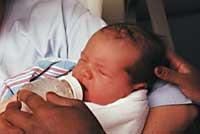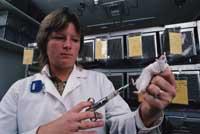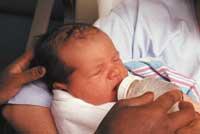Eating or dying your own cells
2005/03/01 Orruño Aguado, Estibalitz - Elhuyar Zientziaren Komunikazioa Iturria: Elhuyar aldizkaria

When a child is born, under the hypocrisy of its charm, most of us do not even look at a small detail: How would that child get the energy she needs in the period from the time she leaves the uterus until she first takes milk?
It seems that newborn children need to feed on the materials of their cells to survive. At birth, the supply of nutrients per placenta is abruptly interrupted. Consequently, newborns face complete fasting while taking breast milk. Due to this period of forced fasting, nature sets in motion a surprising process for the survival of the newborn. This process is known as autophagy.
Autofigual, the cells destroy the components they contain to obtain essential compounds. Subsequently, these compounds are used in obtaining intracellular energy. Amino acids, lipids, sugars and nucleotides are precisely the compounds that cells need for energy. To achieve them, a kind of small canecillos called autophagosomes are created inside the cell. The dogs collect inside the components of the cell and then merge with organelles known as lysososomes. Lysosomes are full of enzymes and degrade the cellular components of autophagosomes to obtain essential compounds.
Studies with mice
A group of scientists from Tokyo investigate the autophagy of newborns. This is the first time this process has been studied in mammals. Researchers have used newborn mice. Specifically, two mouse types have been used to carry out the research, one to avoid autophagy processes in genetically modified mice and the other for common mice. Although both mouse types are similar at birth, scientists have seen that genetically modified mice only survive one day after birth.

In addition, for the study of autophagy activities in different parts of the body, researchers have used a fluorescence system. They have incorporated a special protein into mice. In case of autophagy, this protein emits green light and can be seen through the microscope. Researchers have analyzed different tissues of common mice in the short term. High autophagy activity has been shown in heart, diaphragm, lung, and skin cells. In brain cells, however, they have not seen autophagy.
Well thought out, these results are not surprising. On the one hand, the activity of the heart and diaphragm increases considerably at birth, which might make you think you will need more energy. On the other hand, the external medium of the lungs and skin changes radically from amniotic fluid to the air, which increases the need for energy.
It has not yet been proven that the same thing has happened with the mouse in humans. However, it is very possible that all mammals have to ingest their own cells to cope with the physiology of neonatal fasting. According to scientists, it is logical to think that newborn children also need some mechanism of energy when feeding with placenta is interrupted.
Main objective: to obtain proteins
In the case of humans, the embryo develops for nine months. Of these, in the last two months of pregnancy the child accumulates fats until 16% of his body turns into fat. On the other hand, the child also accumulates carbohydrates in the liver and muscles as the time approaches for expulsion. While breast milk is born, the newborn uses these stores of fat and carbohydrates. But what about the necessary proteins? Where does the newborn come from?

Perhaps your research in Japan can answer the above question. According to scientists, newborn cells obtain by autophagy the amino acids needed to form proteins. These amino acids can be used by the newborn in various ways: obtain energy directly, transform it into glucose in the liver or, as already mentioned, synthesize proteins. Therefore, the main objective of autophagy would be the degradation of intracellular proteins to obtain amino acids.
This has been demonstrated by Tokyo researchers. In fact, within hours of its birth, blood amino acid levels in the genetically modified mouse were very low compared to the normal mouse.
Therefore, although the word autophagy can give some fear, at least in the case of mice, it is essential to survive at birth. As already mentioned, autophagy is a process that occurs in mammals under normal physiological conditions. However, this process, driven by acute fasting, cannot be maintained for a long time and the newborn, as soon as possible, must obtain lost nutrients, especially protein, from milk.
Autophagy: beneficial or harmful?

Autophagy is a process that occurs in the cells of animals, plants, and fungi. This mechanism is very important for the recycling of intracellular proteins and organelles. However, scientists still do not know whether autophagy protects cells or harms them. In fact, they have seen that autophagy is beneficial in some cases and harmful in others. For example, in Parkinson's cells and people suffering from Alzheimer's disease it has been observed that the degree of autophagy is very high.
For some cancers low levels of autophagy have been detected. It seems that autophagy can help prevent cancer when it removes damaged machinery from cells. In fact, this machine can produce free radicals or genetic mutations if it is not removed. On the other hand, they have seen that autophagy is essential to protect against numerous bacteria and viruses. However, some bacteria and viruses manage to scam autophagy. One of them is the virus that causes herpes. This virus contains a gene that stops autophagy.

Gai honi buruzko eduki gehiago
Elhuyarrek garatutako teknologia





